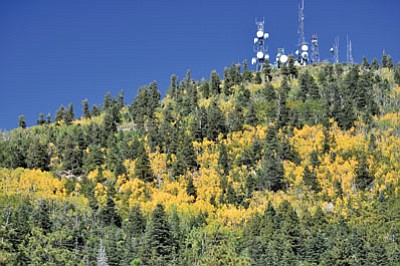Williams Ranger District looks at options to thin Bill Williams Mountain
Options include logging and burning to prevent catastrophic fire and floods
WILLIAMS, Ariz. - Williams Ranger District officials hope to take preventative steps on Bill Williams Mountain including thinning, logging and prescribed burning to reduce the risk of catastrophic fire.
Williams District Ranger Martie Schramm talked about the Environmental Impact Statement (EIS) under review for the 15,200 acre restoration project in a presentation to the Williams Rotary Club Jan. 31.
"When you look at the mountain, the mountain really is pretty when you look at it from this distance," Schramm said. "For those of us that have a forestry background, you go up there and start walking around and unfortunately the mountain really isn't that pretty, it's so thick. There's so many trees, we've got to get some of those out of there."
The proposed forest restoration would help prevent fires. The summer months are particularly dangerous for lightening fires, Schramm said.
"It's just going to take one strike in the right place at the right time," she said. "Being able to respond to some of those lightening fires, especially on Bill Williams Mountain, is getting more and more difficult."
To solve this problem, the Forest Service is considering thinning and logging.
"Thinning is trees anywhere from, well, really small trees and then going up to about 18 inches in diameter," Schramm said.
Schramm said she hopes workers will be able to do table logging and helicopter logging, methods necessary because of the steepness of the mountain.
Another possibility for forest restoration is prescribed burning.
"And of course that's pretty scary and there is big risk," Schramm said, adding that staff will evaluate the weather conditions before using fire.
Schramm named several issues the staff has faced in putting together the forest restoration plan.
Forest Service staff must consider the Mexican spotted owl habitat and Arizona Bugbane plant population on Bill Williams Mountain when planning this project.
The Forest Service has also met with Native American tribes to discuss their concerns with the restoration.
"The mountain is very important to them spiritually and then it has a lot of cultural significance to them as well," Schramm said.
The most significant issue regarding this project is that Bill Williams Mountain is the watershed for the city of Williams.
Schramm brought up the Schultz Fire that burned 15,000 acres northeast of Flagstaff in 2010.
"It's pretty devastating to think about what perhaps could have happened to this city if that fire had occurred over here," she said, referencing the watershed.
Ranger district employees started work on the forest restoration project in 2011 by getting comments from different groups, including Fish and Wildlife Service, county commissioners and Williams residents. Experts such as wildlife biologists, archaeologists, tribal liaisons and soil specialists also helped with the project.
The regional office will review the EIS and Schramm said they hope to publish a decision in early summer. From there, the project will undergo a 45-day appeal period and if all goes well, Schramm said implementation could start in the fall.
Since the project includes such a large area, workers would complete it in phases. The process could take years.
Money for the project could come from the Forest Service budget, watershed improvement money and grants.
- Driver identified in fatal accident on Perkinsville Road Sept. 19
- Latest Tik Tok challenges causing problems for Williams Unified School District
- Search at Grand Canyon turns up remains of person missing since 2015
- Plane wreckage and human remains found in Grand Canyon National Park
- Pumpkin Patch Train departs Williams starting Oct. 5
- Update: Man missing in Grand Canyon National Park hike found alive
- Receding water levels at Lake Powell reveal missing car and driver
- Man sentenced for attack on camper at Perkinsville
- Column: Lumber prices expected to stay high through 2022
- Elk rut season in Grand Canyon: What you need to know
SUBMIT FEEDBACK
Click Below to:






